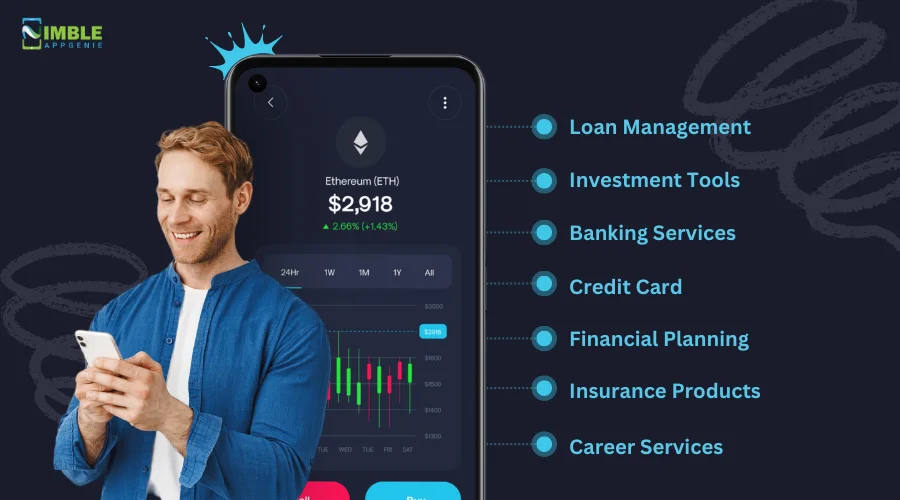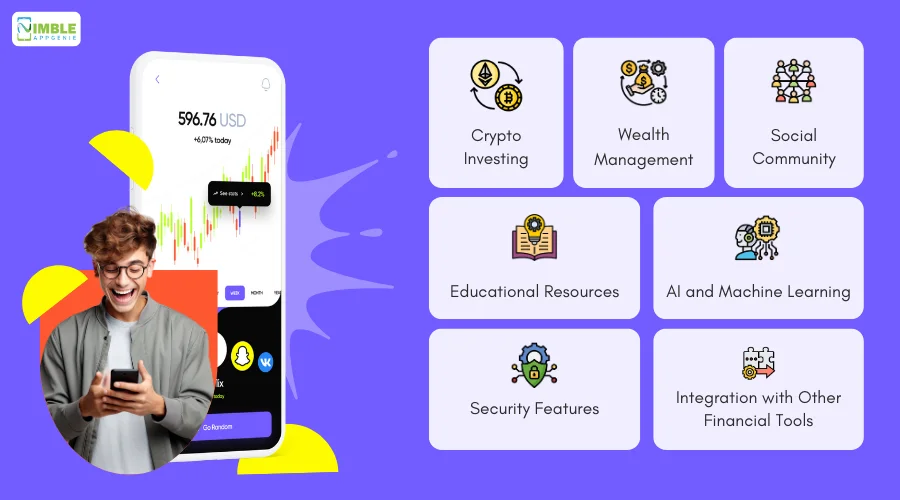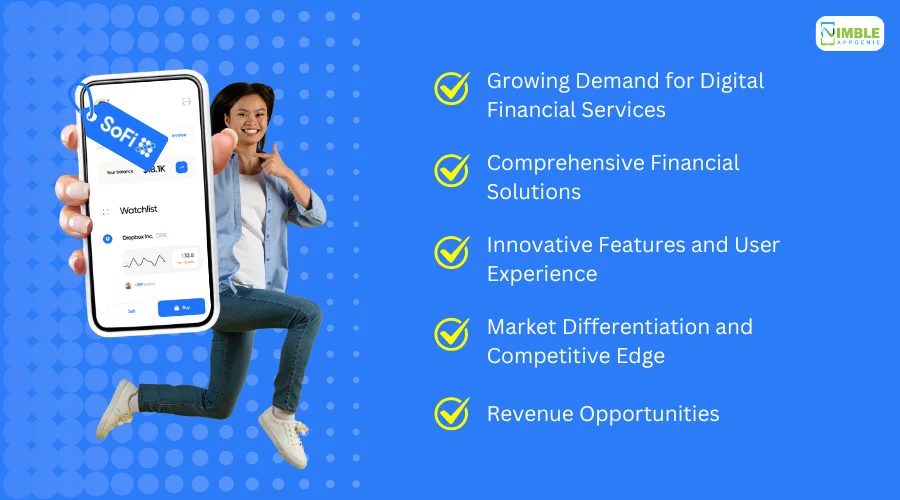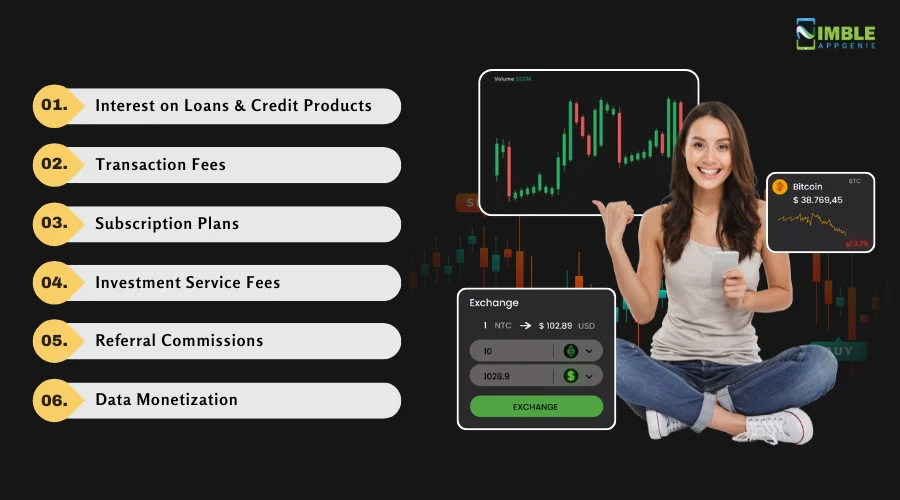Creating an app like SoFi requires a comprehensive understanding of the fintech landscape and a significant financial investment.
SoFi, known for its innovative approach to personal finance, combines various financial services into a single platform.
This includes personal loans, student loan refinancing, investment options, and more.
The cost to develop an app like SoFi ranges from $20,000 to $300,000, depending on various factors such as complexity, features, and development platform.
Whether you’re looking to enter the fintech market or enhance your existing offerings, this comprehensive guide will help you navigate the development process efficiently, ensuring that your app stands out in a competitive market.
Therefore, let’s get right into it:
SoFi – Your One-Stop Solution For Financial Needs
SoFi, short for Social Finance.
It is a comprehensive financial services platform designed to meet all your financial needs.
Whether you’re looking to refinance student loans, take out a personal loan, invest in the stock market, or manage your savings, SoFi has you covered.
The app offers a user-friendly interface that makes managing finances easy and efficient.
With features like personalized financial planning, low-cost investment options, and competitive loan rates, SoFi stands out as a leading fintech solution.
The app also provides access to financial advisors and career coaching, ensuring that users have all the tools they need to achieve financial success.
Develop an app like SoFi to provide a seamless and integrated financial experience for your users.
SoFi App Features: Essentials and Advanced
If you want to develop an app like SoFi, from a NeoBank or loan lending app development perspective, understanding the feature set is very important.
Here’s this fintech app’s feature set, let’s look at it in detail:
♦ Essential Features

1. Loan Management
- Student Loans: Refinance and consolidate existing student loans with competitive interest rates.
- Personal Loans: Access personal loans with flexible terms and low interest rates.
- Mortgage Loans: Apply for home loans and mortgages directly through the app.
2. Investment Tools
- Automated Investing: Utilize robo-advisors for automated, low-cost investment management.
- Active Investing: Trade stocks, ETFs, and cryptocurrencies with no commission fees.
3. Banking Services
- Cash Management: Manage daily finances with a high-interest checking account.
- Savings Accounts: Benefit from high-yield savings accounts with no account fees.
4. Credit Card
- SoFi Credit Card: Earn rewards on purchases, pay bills, and track spending.
5. Financial Planning
- Personalized Financial Advice: Access professional financial advisors for personalized financial planning.
- Budgeting Tools: Use built-in budgeting tools to track spending and manage budgets effectively.
6. Insurance Products
- Life Insurance: Apply for term life insurance policies directly through the app.
- Auto & Home Insurance: Get quotes and purchase auto and home insurance.
7. Career Services
- Career Coaching: Access career coaching services to help with job searches and career transitions.
- Unemployment Protection: Benefit from temporary unemployment protection on loans.
♦ Advanced Features

1. Crypto Investing
- Cryptocurrency Trading: Buy, sell, and hold various cryptocurrencies with real-time price tracking.
2. Wealth Management
- Wealth Advisors: Access to wealth management services for high-net-worth individuals.
- Estate Planning: Comprehensive estate planning services to manage and protect wealth.
3. Social Community
- Member Events: Participate in exclusive events, webinars, and financial workshops.
- Referral Bonuses: Earn rewards by referring friends to the SoFi platform.
4. Educational Resources
- Learning Center: Access articles, videos, and courses on personal finance and investing.
- Financial Literacy Programs: Participate in programs designed to improve financial literacy.
5. AI and Machine Learning
- AI-driven Insights: Get personalized insights and recommendations based on spending and investment patterns.
- Predictive Analytics: Use predictive analytics to forecast financial trends and opportunities.
6. Security Features
- Biometric Authentication: Secure access with fingerprint and facial recognition.
- Encryption and Fraud Protection: Advanced encryption and fraud detection measures to protect user data.
7. Integration with Other Financial Tools
- Third-party Integrations: Connect with other financial tools and platforms for a unified financial management experience.
- API Access: Developers can access APIs for custom integrations and functionality.
By incorporating these essential and advanced features, you can create an app like SoFi that offers a comprehensive, user-friendly financial management solution. Whether you aim to build an app like SoFi, focusing on these features will ensure you meet diverse user needs and stand out in the competitive fintech landscape.
Why Develop An App Like SoFi
Are you planning to develop an app like SoFi?
Developing an app like SoFi presents a lucrative opportunity for businesses and entrepreneurs looking to enter the fintech market.
Here’s why:

-
Growing Demand for Digital Financial Services
The demand for digital financial services is skyrocketing.
Consumers are increasingly turning to online platforms for managing their finances, seeking loans, investing, and more.
According to a study by Statista, the global fintech market is expected to reach $305 billion by 2025, demonstrating the enormous potential in this sector.
Creating an app like SoFi allows you to tap into this growing market, offering consumers the convenience and efficiency they crave.
-
Comprehensive Financial Solutions
SoFi provides a one-stop solution for a wide range of financial needs, from loans and investments to banking and insurance.
This comprehensive approach appeals to users looking for a unified platform to manage their finances.
By developing an app like SoFi, you can offer a diverse range of services that attract and retain customers, enhancing user engagement and loyalty.
-
Innovative Features and User Experience
SoFi’s success is partly due to its innovative features and exceptional user experience.
The app integrates advanced technologies like AI-driven insights, biometric authentication, and personalized financial advice.
By building an app like SoFi, you can incorporate these cutting-edge features to provide a seamless, secure, and personalized experience for your users, setting your app apart from competitors.
-
Market Differentiation and Competitive Edge
In the competitive fintech landscape, differentiation is key.
SoFi’s unique blend of financial services, educational resources, and community engagement gives it a competitive edge.
Developing a SoFi clone allows you to leverage a proven business model while adding unique features to differentiate your app.
This approach not only attracts a broad user base but also positions your app as a leader in the market.
-
Revenue Opportunities
A well-designed fintech app like SoFi offers multiple revenue streams, including loan origination fees, investment management fees, subscription services, and more.
According to McKinsey, the global digital finance market offers revenue potential worth billions. Investing in SoFi app development can unlock substantial financial returns, making it a wise investment for long-term growth.
By creating an app like SoFi, you can meet the evolving needs of today’s digital-savvy consumers, establish a strong market presence, and capitalize on the booming fintech industry.
Average Cost To Develop An App Like SoFi
Developing an app like SoFi involves significant investment due to its complexity and comprehensive features.
On average, the cost to develop an app like SoFi typically ranges from $20,000 to $300,000.
This cost can vary depending on various factors such as the app’s features, design, platform, and development team’s location and expertise.
| Feature/Aspect | Estimated Cost |
| Basic Features (Loans, Investments) | $4,000 – $80,000 |
| Advanced Features (AI, Crypto) | $5,000 – $120,000 |
| UI/UX Design | $2,000 – $20,000 |
| Security Measures | $3,000 – $20,000 |
| Integration with Banking Systems | $3,000 – $40,000 |
| Testing and Quality Assurance | $2,000 – $10,000 |
| Maintenance and Support | $1,000 – $10,000/year |
The cost to develop an app like SoFi depends on a lot of things.
If you are looking for a closer estimate to your planned app, it’s highly recommended that you consult an expert fintech app development company.
Factors That Affect the SoFi Clone App Development Cost
Creating an app like SoFi involves various factors that influence the overall cost to develop an app like SoFi.
Here’s a detailed breakdown of the primary factors affecting the cost to build an app like SoFi:
1] Feature Complexity
The complexity and number of app’s features significantly impact the development cost of an app like SoFi.
Basic features such as user registration, payment processing, and transaction history are essential, while advanced
features like biometric authentication, AI-driven insights, and real-time fraud detection add to the cost. The more complex and feature-rich the app, the higher the development cost will be.
♦ Basic Features
- User Registration and Profile Management: Essential for user onboarding and account management.
- Payment Processing: Handles transactions between users and merchants.
- Transaction History: Allows users to view past transactions.
♦ Advanced Features
- Biometric Authentication: Ensures security through fingerprint or facial recognition.
- AI-driven Insights: Provides personalized financial advice and spending insights.
- Real-Time Fraud Detection: Monitors transactions in real-time to detect and prevent fraudulent activities.
| Feature Complexity | Estimated Cost |
| Basic Features | $4,000 – $80,000 |
| Advanced Features | $5,000 – $120,000 |
Understanding the complexity and scope of features helps in accurately estimating the cost and planning the development process efficiently.
2] Tech Stack
The choice of technology stack for developing a SoFi clone is crucial as it influences the overall performance, scalability, and cost of the app.
The tech stack includes various technologies and tools used for backend development, frontend development, databases, and other essential components.
Here’s a detailed breakdown of the tech stack and its associated costs.
| Tech Stack Component | Technology Options | Description | Estimated Cost |
| Backend Technologies | Node.js, Python, Ruby on Rails | Server-side logic, data management, and integrations | $30,000 – $60,000 |
| Frontend Technologies | React Native, Flutter, Swift | Client-side interfaces and user interactions | $40,000 – $80,000 |
| Database | MySQL, PostgreSQL, MongoDB | Data storage and management | $10,000 – $20,000 |
| Payment Gateway Integration | Stripe, PayPal, Square | Secure payment processing and transaction handling | $15,000 – $25,000 |
| Cloud Hosting | AWS, Google Cloud, Azure | Scalable and reliable hosting solutions | $20,000 – $40,000 |
| Security Measures | SSL, OAuth, Encryption Standards | Protects user data and transactions from breaches | $10,000 – $20,000 |
| APIs and Integrations | RESTful APIs, Webhooks | Facilitates communication between different services | $15,000 – $30,000 |
| Testing and QA | Manual Testing, Automated Testing | Ensures app functionality and performance across various devices | $10,000 – $20,000 |
| Maintenance and Support | Regular Updates, Bug Fixes | Continuous support and improvements post-launch | $10,000 – $20,000/year |
Choosing the right tech stack not only impacts the initial development cost but also the app’s scalability and maintenance expenses in the long run.
The selected technologies should align with your project requirements and business goals.
3] Development Partner Location
The geographical location of your development team plays a significant role in determining the overall cost to develop an app like SoFi.
For example, the cost to develop an app in London is a lot different than cost to develop an app in Kyiv or Texas.
Rates for app development services vary widely across different regions due to differences in living costs, demand, and availability of skilled developers.
Here’s a detailed breakdown of how location affects the development cost.
| Location | Hourly Rate ($) | Pros | Cons |
| North America | $150 – $200/hour | High-quality work, experienced developers, strong communication skills | High cost |
| Western Europe | $100 – $150/hour | High-quality work, skilled developers, good communication, time zone alignment | Relatively high cost |
| Eastern Europe | $30 – $50/hour | Cost-effective, highly skilled developers, strong technical expertise | Potential communication challenges, cultural differences |
| India | $20 – $40/hour | Very cost-effective, large talent pool, experience with diverse projects | Potential communication issues, varying quality |
| Latin America | $40 – $60/hour | Moderate cost, good communication, cultural alignment with North America | Smaller talent pool compared to other regions |
Choosing the right location for your development partner is crucial for balancing cost and quality.
It’s essential to consider not only the rates but also the communication, time zone alignment, and reliability of the developers to ensure a successful project.
4] App Development Platform
The choice of the app development platform is another crucial factor that impacts the cost to develop an app like SoFi.
Deciding whether to build a native app, a hybrid app, or a cross-platform app can significantly affect development time, cost, and overall user experience.
| Development Platform | Technologies | Description | Estimated Cost |
| Native Development | iOS (Swift), Android (Kotlin/Java) | High performance, best user experience | $20,000 – $80,000 per platform |
| Cross-Platform Development | React Native, Flutter, Xamarin | Single codebase, faster development, lower cost | $80,000 – $120,000 |
| Hybrid Development | Ionic, Cordova | Web applications in a native shell, lower performance | $60,000 – $100,000 |
The choice of development platform significantly influences the overall time and cost to develop an app like SoFi.
It is essential to evaluate the pros and cons of each platform based on your project requirements, budget, and desired user experience.
5] Developer’s Expertise and Experience
The expertise and experience of the developers you hire play a critical role in the overall cost and quality of developing an app like SoFi.
Experienced developers bring a wealth of knowledge and skills that can significantly impact the efficiency and success of your project.
| Developer Level | Experience (Years) | Pros | Cons | Hourly Rate ($) |
| Junior Developers | 0-2 | Lower cost, enthusiastic | Require more supervision, less experience | $20 – $40 |
| Mid-Level Developers | 2-5 | Balanced cost, good problem-solving skills | May need occasional guidance on complex tasks | $40 – $80 |
| Senior Developers | 5+ | Highly skilled, excellent problem-solving | Higher cost | $80 – $150 |
| Specialists/Consultants | 10+ | Deep expertise, strategic guidance | Very high cost, often hired short-term | $150 – $300 |
Hiring experienced developers ensures that your project is completed efficiently and to a high standard.
Investing in skilled developers can lead to better performance, fewer bugs, and a smoother development process, ultimately saving time and money in the long run.
How Long Does It Take To Develop SoFi App Clone?
The time required to develop a SoFi app clone can vary significantly based on the complexity of the app, the features you want to include, and the development team’s expertise.
On average, developing a clone of a sophisticated financial app like SoFi can take anywhere from 6 to 12 months.
This app development timeline includes all phases, from initial planning and design to development, testing, and deployment.
| Development Phase | Duration (Weeks) |
| Planning and Research | 2-4 weeks |
| UI/UX Design | 4-6 weeks |
| Backend Development | 8-12 weeks |
| Frontend Development | 8-12 weeks |
| Testing and Quality Assurance | 4-6 weeks |
| Deployment and Launch | 2-4 weeks |
| Total Time | 28-44 weeks (6-12 months) |
Key Factors Influencing Development Time
- Feature Complexity: More advanced features like AI-driven insights, fraud detection, and multi-currency support can extend the development timeline.
- Team Expertise: A skilled and experienced development team can significantly reduce development time.
- Platform Choice: Developing for multiple platforms (iOS, Android) simultaneously can add to the development duration.
- Integration Requirements: Integrating with third-party services and ensuring compliance with financial regulations can also impact the timeline.
By understanding the phases and factors involved, you can better plan and allocate resources for developing a robust and feature-rich SoFi app clone.
Here’s How To Generate ROI: Monetization Strategies
To ensure the profitability of a SoFi app clone, implementing effective monetization strategies is crucial.
Here are several ways to generate ROI, along with potential revenue estimates for each method:

► Interest on Loans and Credit Products
One of the primary revenue streams for financial apps like SoFi is the interest earned on loans and credit products, including personal loans, student loans, and credit card products.
This model leverages the app’s ability to offer competitive loan products to users, thereby generating steady interest income.
Potential Revenue:
- Interest rates typically range from 5% to 20% annually, depending on the loan type and borrower’s creditworthiness.
- For instance, with $10 million in loans at an average interest rate of 10%, the annual revenue from interest could be approximately $1 million.
► Transaction Fees
Charging transaction fees on financial activities such as fund transfers, bill payments, and investment transactions can be a consistent source of income.
These fees can be set at a percentage of the transaction value or as a flat fee, providing flexibility in revenue generation.
Potential Revenue:
- Transaction fees generally range from 0.5% to 2% per transaction.
- If the app processes $100 million in transactions monthly with an average fee of 1%, the monthly revenue could be around $1 million, translating to $12 million annually.
► Subscription Plans
Offering premium subscription plans with additional features and benefits, such as higher interest rates on savings, lower loan rates, and exclusive financial tools, can attract users willing to pay for enhanced services.
These plans can be tailored to cater to different user segments.
Potential Revenue:
- Monthly subscriptions can range from $5 to $50, depending on the tier.
- With 10,000 subscribers at an average monthly fee of $20, the annual revenue could be $2.4 million.
► Investment Services Fees
Earning fees from investment management services, including robo-advisory services, stock trading, and portfolio management, can be a lucrative revenue stream.
These services cater to users looking for integrated financial solutions within the app.
Potential Revenue:
- Management fees typically range from 0.25% to 1% of assets under management (AUM) annually.
- With $500 million in AUM at an average fee of 0.5%, the annual revenue could be $2.5 million.
► Referral Commissions
Partnering with other financial institutions, insurance companies, and service providers to earn referral commissions for bringing in new customers can diversify revenue streams.
These partnerships leverage the app’s user base to generate additional income.
Potential Revenue:
- Referral commissions can vary widely but generally range from $10 to $100 per referral.
- With 10,000 successful referrals annually at an average commission of $50, the revenue could be $500,000.
► Data Monetization
Selling anonymized user data and insights to third parties for market research and advertising purposes can be a substantial revenue source. This strategy must be implemented with strong data privacy measures to maintain user trust.
Potential Revenue:
- Data monetization revenue can be significant, depending on the size of the user base and the value of the data.
- For example, selling data insights for $0.50 per user per month for a user base of 500,000 could generate $3 million annually.
Implementing a mix of these monetization strategies can significantly enhance the ROI for a SoFi app clone.
Each strategy offers different revenue potentials and can be tailored to fit the specific business model and user base of the app.
Partner with Nimble AppGenie to Create Your Dream Banking App
Are you ready to transform your financial services with a state-of-the-art banking app?
Nimble AppGenie is the leading mobile banking app development company dedicated to turning your vision into reality.
With our expert team of developers, we provide end-to-end solutions tailored to your specific needs.
From conceptualization and design to deployment and maintenance, we ensure your app stands out in the competitive market.
Partner with us to leverage cutting-edge technology and deliver a seamless, secure, and engaging banking experience to your users.
Conclusion
Developing an app like SoFi involves strategic planning, a comprehensive understanding of the market, and a significant investment in both time and resources. By focusing on key features, leveraging effective monetization strategies, and choosing the right development partner, you can create a successful app like SoFi. The estimated cost to create a SoFi app clone ranges from $200,000 to $500,000, depending on the complexity and features included. With careful execution, your app can achieve a strong return on investment and establish a significant presence in the fintech industry.
FAQs

Niketan Sharma is the CTO of Nimble AppGenie, a prominent website and mobile app development company in the USA that is delivering excellence with a commitment to boosting business growth & maximizing customer satisfaction. He is a highly motivated individual who helps SMEs and startups grow in this dynamic market with the latest technology and innovation.
Table of Contents






No Comments
Comments are closed.